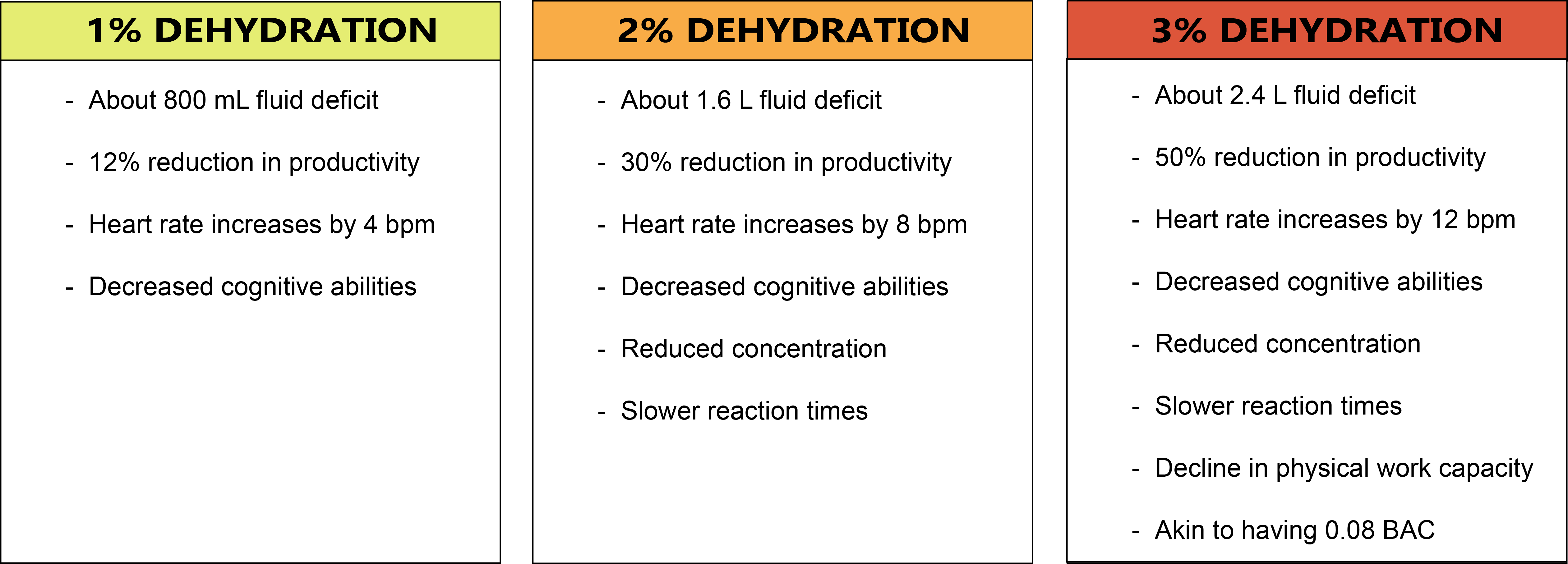This page includes: Understanding Dehydration, Monitoring Your Hydration Levels, THORZT™ – Your Ultimate Hydration Solution, Get in Touch with Us, and Explore Related Products
Stay Ahead: Hydration Safety in the Workplace
Welcome back to Feature Friday! With summer upon us, it’s crucial to emphasize the importance of keeping cool and hydrated. This article continues our Heat Stress Relief series, focusing on dehydration, its risks, and why plain water alone isn’t always sufficient. If you haven’t read our previous posts on heat stress, I’d recommend checking out “How to Combat Heat Stress†and “The Latest Tech for Preventing Heat Stress.â€
Understanding Dehydration
About 55-60% of the human body is made up of water, and all our organs, systems, and cells depend on adequate hydration for optimal performance. Dehydration is a major contributor to heat stress and happens when you lose fluids and nutrients faster than you can replace them. When your body heats up—whether due to the environment or physical exertion—it cools itself through sweating. Construction workers and laborers typically sweat around four to five liters during a ten-hour shift. Combine this with the fact that over 60% of workers start their day already dehydrated, and you’ll see why dehydration poses such a significant safety risk in the workplace.
Signs that you might be dehydrated include irritability, drowsiness, confusion, reduced skin elasticity, a rapid heart rate, sunken eyes, exhaustion, and darker urine. To determine how dehydrated you are, take one percent of your weight in kilograms and convert it to liters. For example, an 80 kg man (about 175 lbs) would need to consume approximately 0.8 liters of water to recover from one percent dehydration.

Monitoring Your Hydration
Managing hydration isn’t as straightforward as drinking water only when you feel thirsty. When we sweat, we lose not just water but also vital salts and minerals called electrolytes. Electrolytes play critical roles like maintaining water balance, making it equally important to restore them while hydrating.
In some severe cases, drinking only water can lead to 'involuntary dehydration,' where despite consuming water, your body doesn’t retain it properly. There are various methods to track and sustain your hydration levels at work. The simplest way is to check the color of your urine. A pale yellow indicates proper hydration, while darker shades suggest dehydration.

Another approach is Programmed Drinking, where you sip small amounts of fluid regularly, regardless of thirst. We suggest drinking about 250 mL of water every 15 minutes, alternating every third drink with an electrolyte beverage. Lastly, staying vigilant for symptoms like those mentioned earlier can help—your body often sends these signals before you feel thirsty, so proactively hydrating is key.
THORZT™ – Your Ultimate Hydration Solution
Developed by former Olympians, THORZTâ„¢ is an electrolyte-replenishing supplement designed to keep you hydrated. Their idea was that if their formula could support rigorous training schedules, it would benefit workers too. Most sports drinks are isotonic, meaning they have the same concentration of solutes as your blood, allowing nutrients to pass easily through cell walls. THORZTâ„¢, however, is hypotonic, with fewer solutes compared to your cells, prompting water to flow into the cells quickly, rehydrating them swiftly.

THORZT™ contains electrolytes similar to other popular brands (sodium, potassium, magnesium), plus L-Glutamine and essential Branch Chain Amino Acids (BCAAs) to aid muscle recovery, low GI carbs for sustained energy, and generous doses of B and C vitamins to boost immunity. It’s also free of sugar and caffeine.
Get in Touch
THORZT™ hydration drink mixes are now available both online and at all MacMor locations. Reach out to your local branch or email us at [insert email] to learn why THORZT™ is the perfect hydration solution for your team. Stay safe, stay hydrated, and let’s beat the heat together!
The nano-imprint resin employed for fabricating diffractive optical waveguides boasts a high refractive index range of 1.7 to 1.9, coupled with exceptional transparency and a suite of superior optical characteristics. This resin exhibits excellent flow and filling capabilities, adeptly conforming to a diverse array of nano-imprint patterns. Its versatility makes it an ideal material for the production of sophisticated micro-nano optical devices, catering to the demands of high-precision manufacturing processes.
High Refractive Index Diffractive Waveguides,Nano Imprint For Diffractive Optical Waveguides,Nanoimprint Adhesives For Micro/Nano Optics,High Refractive Index
Ningbo Merak Advanced Materials Technology Co., Ltd. , https://www.merak-tech.com